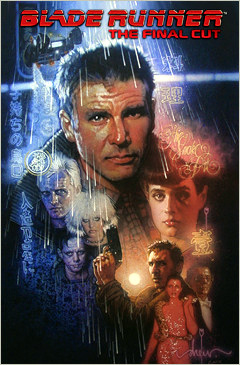 |
Site created 12/15/97.

page added: 10/2/07
Blade Runner: The Final Cut
1982/2007 - The Blade Runner Partnership/Warner Bros.
Film review by Bill Hunt of The Digital Bits
|
||
Set
in a dirty, run-down Los Angeles of the (then) near future, Blade
Runner follows the efforts of a somewhat reluctant police
detective named Deckard (played by a young Harrison Ford, who was
just coming into his own as an actor, fresh off the experience of
making The Empire Strikes Back
and Raiders of the Lost Ark).
Deckard's job is to "retire" (read: kill) rogue,
human-like androids called Replicants. These Replicants are made to
do Humanity's dirty work, acting as soldiers, laborers and sex
servants, and they're given implanted human emotions and memories to
make them seem more realistic. But those emotions eventually become
troublesome as, over time, the Replicants begin to develop real
consciousness and identities of their own. For this reason, they're
given limited, four-year life spans before they automatically
deactivate. But when they become aware of their own "mortality,"
some Replicants become desperate, choosing to run and hide in the
shadows of regular human society, in the vain hope of saving
themselves... or at least understanding the meaning of their brief
existence. When they do, it's Deckard's job to find and destroy them
before they can (potentially) take out their anger on the humans
around them.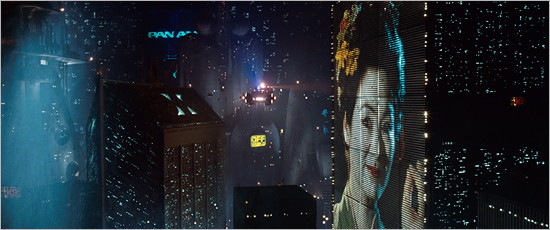 In addition to Ford's steady on-screen presence, Blade Runner features great, seminal performances by the likes of Rutger Hauer, Edward James Olmos, Sean Young and Daryl Hannah, not to mention a host of fantastic character actors. The film's production design was overseen by legendary futurist Syd Mead, giving it a highly unique visual style never-before-seen on the big screen. The film also includes a sparse but evocative score by composer Vangelis (more commercially known for his work on Chariots of Fire). But it's the efforts of director Ridley Scott for which this film is perhaps best known. If The Duelists was the film that first garnered Ridley Scott critical notice, and it was Alien that brought him to the attention of a much wider audience... Blade Runner is the film that solidified his acclaim among hard-core cinephiles and earned him a loyal legion of fans. Ridley's near manic attention to detail and his use of rich, stylish and atmospheric staging and camera setups were on full, unrestrained display here - a fact that caused him significant problems with his producers and the studio at the time. Surprisingly, when the film was released into theaters in 1982, it was a critical and commercial bomb. Many people just didn't know what to make of it. Over the years, however, critical opinion has shifted drastically. Blade Runner is, today, considered one of the best films (if not THE best) in Scott's decidedly impressive body of work. It showcases Ridley at his most... well, Ridley. Even upon its original theatrical release, Blade Runner quickly and definitively set its director apart from other filmmakers as a singular, visionary talent. 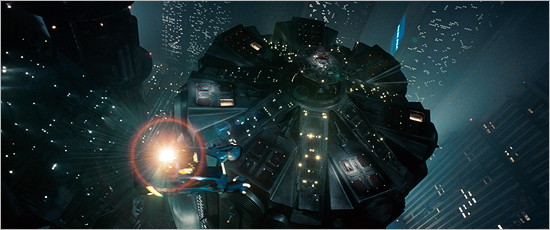 In the early 1990s, Warner noticed something of a resurgence in the film's popularity. To take advantage of this, a so-called Director's Cut version of the film was created and released into theaters in 1992. This version removed Deckard's much-maligned voiceover narration and the theatrical cut's "happy" ending, and restored the infamous "unicorn" scene. It was also one of the first titles that Warner released on the nascent DVD format back in early 1997. Unfortunately, though, this wasn't really a true director's cut, as Ridley himself had little involvement. A few years later, in 2000, an effort was mounted to produce a legitimate Director's Cut of the film, and to give it the elaborate DVD special edition treatment its fans had long sought. Some work was begun at this stage, but a variety of business and legal obstacles prevented the project from really gaining momentum. Eventually, however, the Blade Runner Partnership and Warner Bros. were able to come to an agreement that cleared the way for the effort to move ahead, just in time to celebrate the film's 25th anniversary in 2007. An incredible wealth of material related to Blade Runner's original production was unearthed from the vaults, including some 977 cans of original film negative. Much of this footage was scanned at 4K resolution (some of the 65mm effects footage was even scanned at 8K) and an extensive restoration was begun. Restoration producer Charles de Lauzirika worked closely with Warner and Ridley Scott to assemble the director's ultimate version of the film. The result is Blade Runner: The Final Cut, which makes its debut this Friday, October 5th, in a limited theatrical run in New York (at the Ziegfeld) and Los Angeles (at the Landmark). It also arrives on DVD, Blu-ray Disc and HD-DVD from Warner Home Video on December 18th (click here for all the details on the various versions that will be available on disc). The running time of The Final Cut is virtually identical to the original theatrical version, but there have been many changes, most of them quite subtle. First, the film has undergone a painstaking frame-by-frame digital restoration to remove unwanted dust, scratches and other age-related image defects. The entire cut has been color-timed to Ridley's specifications. The film's soundtrack has been remixed and remastered to take best advantage of the latest surround sound technology (so when those Spinners fly past now, you'll really hear them zoom towards you and away). As you'd expect, the film's editing has been massaged here and there, but this time to Ridley's exact instructions. Like the 1992 version, this new Final Cut omits the Deckard narration and the happy ending. Ridley has made subtle trims here and there to tighten the footage (without the narration, he felt that some shots went on a little too long). But he's also added material. For example, the unicorn scene is now a little longer and more effective (it's actually the originally-intended version, the complete footage for which couldn't be found for use in the '92 cut). A little bit of footage from both the "international" and "workprint" versions has been inserted into the film as well, including a number of street/atmosphere shots and more intense moments of violence involving the various character deaths. And here's something fans will appreciate: This is only a publicity still (unlike the two previous images, above, which ARE actual screen shots from the new version), but those of you who recall the infamous hockey-masked geisha dancers will be pleased to know that they do appear in The Final Cut... 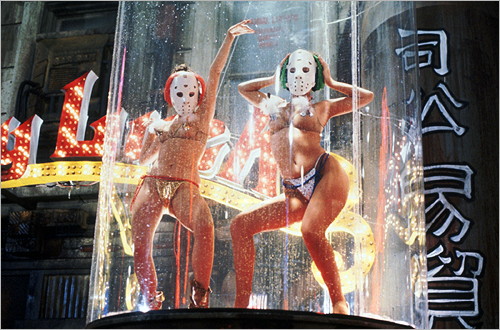 Scores of subtle digital changes and tweaks have been made to correct problems that couldn't be addressed during the original production. For example, the wires supporting the practical, on-set Spinner vehicles have been removed. In a couple of street shots, members of the production crew accidentally appeared in the edges of the frame - they're gone now. Various matte lines have been erased, and detail that was lost due to matte issues has been restored. When you see the infamous "eye" shot at the beginning of the film, the optical printing process employed at the time wouldn't allow for a moving image of the eye to be used. So now, in The Final Cut, you'll notice the pupil iris slightly in reaction to the plume of fire billowing before it. Other digital corrections fix continuity errors. In the original shooting script, Leon and Deckard fought in the street before Zhora was retired, so the make-up reflected this on set. When the film was edited together, however, Leon and Deckard's fight was moved to after Zhora's retirement. But the bruise on Deckard's face from the fight was still there, before the fight actually happened on screen, so it's been erased digitally. In another instance, the first time you see Roy Batty on screen in the sidewalk Vidphone booth, the shots were actually stolen from later in the film (a moment of Roy at the Tyrell Corporation, I believe, and a shot of him in the Bradbury building). So the lighting and the backgrounds you saw in those shots didn't match the booth or the rain-soaked streets behind it. Now they do. There's also a scene where Deckard is talking to an old Asian woman about the snake scale he's found. She's reading a serial number from a microscope... but when you saw that serial number on the screen, it didn't match. Now it does. The vast majority of these digital effects tweaks are so subtle that only fans who are intimately familiar with the film will even notice them. On the other hand, a few of the digital fixes correct more serious problems with the film in its previous incarnations. For example, when Roy releases the dove at the end of the film, the skyline in the shot where the bird flies away just didn't match anything you'd seen before. So a new digital L.A. cityscape, circa 2019, was created for the shot so that it does finally match. There's also a shot when Deckard is talking to the snake dealer, Abdul Ben-Hassan. You hear Deckard talking, but his lip movements didn't match the dialogue. Harrison Ford was unavailable due to scheduling issues, so his son Ben was brought in correct this. Ben was shot on an effects stage from exactly the same angle, wearing exactly the same scar (via make-up) that his father has on his chin, saying the correct lines. His mouth was digitally inserted over his father's seamlessly. Of course, many of you by now know of the infamous reshoot (from earlier this year) featuring the character Zhora. When news of this leaked on the Net, it sparked an outcry from fans who feared that Ridley was pulling a George Lucas and drastically altering the film with all new scenes. Nothing could be further from the truth, of course, but the Zhora reshoot was what triggered the most controversy, so here's what it was about: Back in 1982, actress Joanna Cassidy wasn't allowed to do the stunt where Zhora crashes through the window panes. But if you watch the film closely, especially now in high-definition, it's painfully obvious that it's a stuntwoman in those shots. I mean, it's not even close. The woman has a bad afro-like wig on and it's bouncing around so much in those shots that she looks like Ronald McDonald going through the glass. So Cassidy was brought back in, dressed in her original costume and was given the same snake tattoo on her face. Then she was shot on a greenscreen stage, going through the same movements as the stuntwoman. Her face and body angles were matched to the original stuntwoman frame by frame, so they're identical. Cassidy's head was then digitally inserted over the stuntwoman's and it was blended together, color-corrected and matched seamlessly. So now, when you see Zhora crash through the glass, it's actually Zhora all the way through. The result is just amazing. The first time I saw the finished sequence a few months ago, I was actively looking for the effect... and I completely missed it. That's how good a job the CG team has done on this. But why take my word for it? I'll let you judge for yourself. Here's a DVD frame grab of what the shot of Zhora crashing through the glass looked like in the original version of the film... 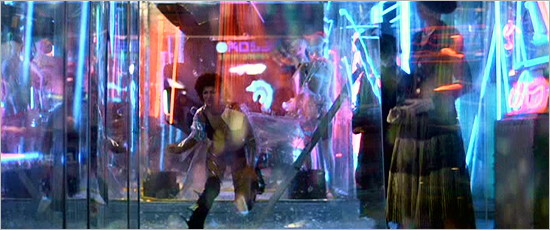 You'd never guess that was a stuntwoman, right? Yeah, right. Now here's the new digital effects shot - the actual shot from The Final Cut - in which the head of actress Joanna Cassidy has been has been inserted to replace that of the stuntwoman. 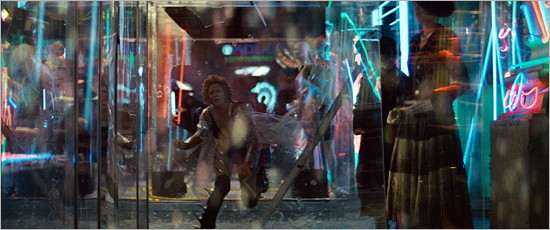 The result is completely natural looking, just as it should be. I've seen this shot projected in a real theater on the big screen, and it works perfectly. It's astonishing how well all this has been done. It's so smooth you barely notice it. It's only when you go back and watch the original scene on DVD, that you fully appreciate how startling the difference is... and just how good the new effects shots actually are. In fact, when you see The Final Cut for yourself, I think you'll really appreciate what a tremendous and pain-staking effort has been mounted to smooth out all the rough edges in Ridley Scott's film, as we've known it these many years. If you haven't guessed yet, by the way, I'm a real fan of Blade Runner. Simply put, this is one of my all-time favorite films. That said, Blade Runner: The Final Cut is a breathtaking experience. This is truly the ultimate vision of a classic. It's just extraordinary after all these years to discover so much that's new here, and to realize just how well this 25-year-old masterpiece holds up even today. If you love Blade Runner like I do, this new cut is simply not to be missed. Be sure to catch it on the big screen if you can. But whether you're able to see it in theaters or not, rest assured that the DVD and high-def versions promise to deliver the film in exceptional quality, with an amazing wealth of bonus features - the special edition we've all been waiting for. Prepare to be dazzled... and to FINALLY see Blade Runner, as it was meant to be seen, for the very first time. Film Rating: A+ Bill Hunt billhunt@thedigitalbits.com |
 |
| Site
designed for 1024 x 768 resolution, using 16M colors and .gif 89a
animation. © 1997-2015 The Digital Bits, Inc., All Rights Reserved. billhunt@thedigitalbits.com |
